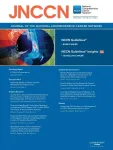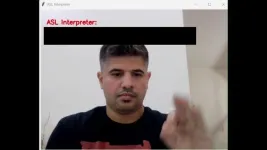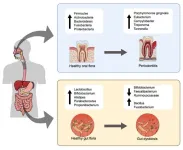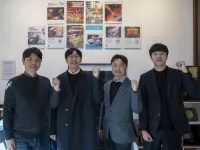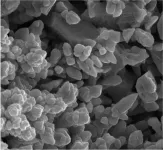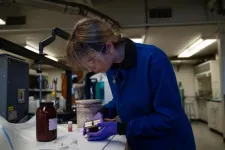(Press-News.org) PLYMOUTH MEETING, PA [April 9, 2025] — New research in the April 2025 issue of JNCCN—Journal of the National Comprehensive Cancer Network found significant disparities based on race, socioeconomic status, and other factors when it came to quality of care and outcomes for people with metastatic pancreatic adenocarcinoma (mPDAC)—which is associated with very high cancer mortality. The researchers used the Surveillance, Epidemiology, and End Results (SEER)-Medicare database to study 14,147 patients who were diagnosed with mPDAC between 2005-2019. Quality scores were determined based on those who received 1) guideline-concordant systemic therapy, 2) palliative care, and 3) a cancer-specific survival of more than 12 months.
Patients with a higher measure on the Social Vulnerability Index (SVI) were 30% less likely to experience at least one of the three quality indicators. Notably, when race and economic status were separated out—individuals who were a member of an underserved racial or ethnic group were 25% less likely to experience one or more quality indicator, regardless of income. Lower socioeconomic status correlated with a 34% lower chance of experiencing a quality indicator, independent of race.
“The results of our study highlight the need for targeted interventions to mitigate disparities in cancer care,” said lead author Diamantis Tsilimigras, MD, PhD, The Ohio State University Wexner Medical Center and James Comprehensive Cancer Center. “Federal policies that expand Medicaid or possibly expand Medicare coverage for palliative care can help reduce disparities. Furthermore, policies that address social determinants of health—including financial aid for the most vulnerable populations as well as understanding and addressing potential implicit biases relative to treatment recommendations—could help address disparities in equal access to care.”
The study found that patients who did receive appropriate systemic and/or palliative care were more likely to survive longer than a year after being diagnosed. They also found improvement over time, across the study period from 2005 to 2019, in both quality scores and longevity.
“Ensuring that all patients, regardless of their background, receive guideline-concordant care is important to improve outcomes for patients with metastatic pancreatic cancer,” added senior author Timothy M. Pawlik, MD, PhD, MPH, MTS, MBA, The Ohio State University Wexner Medical Center and James Comprehensive Cancer Center. “We found that while adherence to NCCN Guidelines improved over time, there remain significant disparities in the receipt of guideline-concordant care among patients with metastatic pancreatic cancer which can, in turn, affect outcomes.”
Jason S. Gold, MD, Associate Professor, Surgery, Harvard Medical School—who was not involved in this research—commented: “There is increasing recognition of the persistence of disparities in treatment and outcomes for pancreatic cancer. This study adds to this body of knowledge by showing that social vulnerability, unmarried status, and lower income were all independently associated with lower quality care for metastatic pancreatic ductal adenocarcinoma.”
Dr. Gold is the author of a longer response to this study that can also be found in the April issue of JNCCN. To read the entire study “Quality Score Among Patients With Metastatic Pancreatic Adenocarcinoma: Trends, Racial Disparities, and Impact on Outcomes” and the corresponding “The Last Word” commentary, visit JNCCN.org.
# # #
About JNCCN—Journal of the National Comprehensive Cancer Network
More than 25,000 oncologists and other cancer care professionals across the United States read JNCCN—Journal of the National Comprehensive Cancer Network. This peer-reviewed, indexed medical journal provides the latest information about innovation in translational medicine, and scientific studies related to oncology health services research, including quality care and value, bioethics, comparative and cost effectiveness, public policy, and interventional research on supportive care and survivorship. JNCCN features updates on the NCCN Clinical Practice Guidelines in Oncology (NCCN Guidelines®), review articles elaborating on guidelines recommendations, health services research, and case reports highlighting molecular insights in patient care. JNCCN is published by Harborside/BroadcastMed. Visit JNCCN.org. To inquire if you are eligible for a FREE subscription to JNCCN, visit NCCN.org/jnccn/subscribe. Follow JNCCN at x.com/JNCCN.
About the National Comprehensive Cancer Network
The National Comprehensive Cancer Network® (NCCN®) is marking 30 years as a not-for-profit alliance of leading cancer centers devoted to patient care, research, and education. NCCN is dedicated to defining and advancing quality, effective, equitable, and accessible cancer care and prevention so all people can live better lives. The NCCN Clinical Practice Guidelines in Oncology (NCCN Guidelines®) provide transparent, evidence-based, expert consensus-driven recommendations for cancer treatment, prevention, and supportive services; they are the recognized standard for clinical direction and policy in cancer management and the most thorough and frequently-updated clinical practice guidelines available in any area of medicine. The NCCN Guidelines for Patients® provide expert cancer treatment information to inform and empower patients and caregivers, through support from the NCCN Foundation®. NCCN also advances continuing education, global initiatives, policy, and research collaboration and publication in oncology. Visit NCCN.org for more information.
END
For generations, sailors around the globe have reported a mysterious phenomenon: Vast areas of the ocean glow steadily at night, sometimes for months on end. The light is bright enough to read by and is oddly similar to the green and white aura cast by glow-in-the dark stars that have decorated children’s rooms. Stretching over ocean space as broad as 100,000 square kilometers, the light can, at times, even be seen from space.
This rare bioluminescent display was coined by sailors as “milky seas.” Despite being encountered for centuries, scientists still know very little about what causes this glowing effect because ...
A groundbreaking study presents a comprehensive approach to restructuring medium-level voltage (MLV) distribution systems that enhances reliability while reducing both energy losses and carbon emissions.
The study introduces an innovative "N+1 bus configuration" for radial distribution systems (RDS) - a simple yet powerful modification to conventional power networks that adds just one additional tie line to existing systems. This seemingly minor change delivers remarkable improvements in system performance when combined with distributed renewable energy resources (DER).
The research team conducted extensive testing on both real-time radial ...
For millions of deaf and hard-of-hearing individuals around the world, communication barriers can make everyday interactions challenging. Traditional solutions, like sign language interpreters, are often scarce, expensive and dependent on human availability. In an increasingly digital world, the demand for smart, assistive technologies that offer real-time, accurate and accessible communication solutions is growing, aiming to bridge this critical gap.
American Sign Language (ASL) is one of the most widely used sign languages, consisting of distinct hand gestures that represent letters, ...
There is growing recognition in medicine that what happens in one part of the body can ripple through others. That idea is now being explored in a surprising place: the mouth. A new review by an international group of researchers has examined the mounting evidence linking periodontal disease—commonly known as gum disease—to chronic liver conditions, including cirrhosis, metabolic dysfunction-associated steatotic liver disease (MASLD), and alcohol-related liver disease. Though the mouth and liver are separated ...
The Korea Institute of Energy Research (President Yi Chang-keun, hereinafter referred to as “KIER”) has successfully developed ultra-lightweight flexible perovskite/CIGS tandem solar cells and achieved a power conversion efficiency of 23.64%, which is the world’s highest efficiency of the flexible perovskite/CIGS tandem solar cells reported to date. The solar cells developed by the research team are extremely lightweight and can be attached to curved surfaces, making it a promising candidate for future applications in buildings, vehicles, aircraft, and more.
Crystalline silicon-based single-junction solar cells ...
A comprehensive study has examined the magnetic field emissions (MFE) from vehicle-mounted wireless power transfer (WPT) systems, providing critical insights for ensuring user safety during electric vehicle charging. As wireless charging technology gains popularity for fleet vehicles and accessibility applications, understanding and controlling electromagnetic field exposure becomes increasingly important.
Researchers conducted extensive physical measurements around a vehicle equipped with an in-house designed WPT system, examining how various factors affect magnetic field emissions where users might be positioned during charging operations. The study specifically investigated:
- ...
Cancer diagnoses traditionally require invasive or labor-intensive procedures such as tissue biopsies. Now, research published in ACS Central Science reveals a method that uses pulsed infrared light to identify molecular profiles in blood plasma that could indicate the presence of certain common cancers. In this proof-of-concept study, blood plasma from more than 2,000 people was analyzed to link molecular patterns to lung cancer, extrapolating a potential “cancer fingerprint.”
Plasma is the liquid portion of blood, depleted of any ...
Wear and tear on plastic products releases small to nearly invisible plastic particles, which could impact people’s health when consumed or inhaled. To make these particles biodegradable, researchers created plastics from plant starch instead of petroleum. An initial study published in ACS’ Journal of Agricultural and Food Chemistry shows how animals consuming particles from this alternative material developed health problems such as liver damage and gut microbiome imbalances.
“Biodegradable starch-based plastics may not be as safe and health-promoting as originally assumed,” ...
Iron and its alloys, such as steel and cast iron, dominate the modern world, and there’s growing demand for iron-derived products. Traditionally, blast furnaces transform iron ore into purified elemental metal, but the process requires a lot of energy and emits air pollution. Now, researchers in ACS Energy Letters report that they’ve developed a cleaner method to extract iron from a synthetic iron ore using electrochemistry, which they say could become cost-competitive with blast furnaces.
"Identifying oxides which can be converted to iron metal at low temperatures is an important ...
University of Oregon chemists are bringing a greener way to make iron metal for steel production closer to reality, a step towards cleaning up an industry that’s one of the biggest contributors to carbon emissions worldwide.
Last year UO chemist Paul Kempler and his team reported a way to create iron with electrochemistry, using a series of chemical reactions that turn saltwater and iron oxide into pure iron metal.
In their latest work, they’ve optimized the starting materials for the process, identifying which kinds of iron oxides will make the chemical reactions the most cost-effective. That’s a key ...
